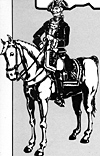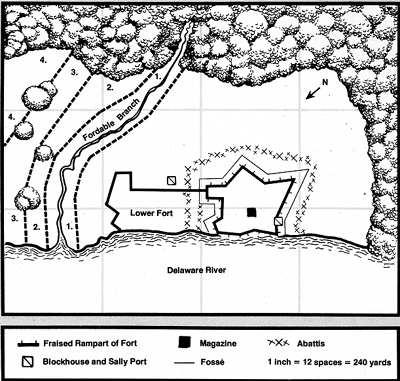 This scenario is designed using
historical data. Any set of rules that
allows fighting in brigade or smaller units
would be acceptable. Some house rules may
be needed to give both players an equal
chance, depending on the rules system used.
Many sets of rules lack good fort assault
sections, so be careful in making your
alterations. The author recommends The
Complete Brigadier, by John Grossman,
though even this fine system would need minor
alteration for the Continental fire control.
This scenario is designed using
historical data. Any set of rules that
allows fighting in brigade or smaller units
would be acceptable. Some house rules may
be needed to give both players an equal
chance, depending on the rules system used.
Many sets of rules lack good fort assault
sections, so be careful in making your
alterations. The author recommends The
Complete Brigadier, by John Grossman,
though even this fine system would need minor
alteration for the Continental fire control.
The miniatures rules system, The Complete Brigadier by J. F. Grossman is Copyright 1982 Adventure Games, Inc.
Historical Situation
You rarely hear of the Battle at Fort Mercer. Histories of the American Revolution seldom make more than a passing reference to this struggle, which saw some of the most savage combat of the war, Gamers tend to avoid storming operations. Fort Mercer, however, combines a nice odds ratio with such a rich historical background that it is a challenging command for either of the two combatants.
Reference for Hessian mounted officer was taken from Funcken, L'unifoirme et les armes des soldats de la Giverve en Dentelle, Castleman 1975.
This battle was packed with emotion. The American, Colonel Christopher Greene led between 400 and 500 men of the First & Second Rhode Island Regiments. His orders were to hold out at any cost in a small mud stockade, isolated on the eastern shore of the Delaware River, 40 miles from the main army.
His task was to protect a wall of spikes buried in the river just below Philadelphia to prevent the Royal Navy from sailing into the port. Greene realized his dire straits. He could hear the constant bombardment of the besieged post at the other end of the barrier: the British were closing the noose on Fort Mifflin. Howe would surely attack and attempt to storm Fort Mercer. Greene kept his little garrison busy partitioning the fort, for it was too large to be efficiently defended by so few Continentals.
Then, the local militia reported that an enemy column had crossed the Delaware by boat and was marching on Mercer. The enemy however, was not British. With their shiny mitres gleaming in the autumn sunlight, these advancing men were Hessian. Three full battalions were Hessian grenadiers. Some of Europe's most feared, rigidly disciplined soldiers were about to throw themselves on his field fortification.
Upon being informed of the approaching Hessian column, Col. Greene consolidated his position in Fort Mercer. Not having room or ammunition for the militia in the area, he instructed them to leave and harass the enemys rear. He then placed his garrison of Continentals in their positions.
Astride a fine steed, riding near the van of ,his forces, Colonel Carl Emil von Donop was bracing himself for a difficult task. Storming field works was never easy, and though the rebels had run in terror from his battalions on some fields of battle, field works always seemed to give these colonists more spirit.
Despite von Donop's urgent request for additional artillery, General Howe would have none of it. Yet this was the Hessian's chance to prove his own ability as an independent commander, Howe needed the port open immediately, for without the reduction of these forts, the Royal Navy had to land In distant Chester. The supply columns were constantly being raided by bands of Continentals as well as by the pesky local militia.
As he neared the clearing surrounding Fort Mercer, Count von Donop's heart raced. Of course he would offer the honorable surrender to the enemy, but rebels never accepted, One swift rush across the plain, up and over the rampart, a few seconds of scuffle, and the Hessian colors would fly over the ramparts...
Set up:
American Deployment:
The American player should place his troops anywhere inside the walls of the fort, concealed.
At least three sections of artillery, including a minimum of two sections of 18# guns, must be located by the American player facing. the channel of the Delaware River and may not be relocated during the course of the battle.
Hessian Deployments
The Hessian player may place his troops anywhere within the woods surrounding the fort, and should write orders for the attacks that von Donop is not accompanying. He may also place his artillery in a section sufficient to cover his battery or batteries. This section of works is of the lightest variety If Donop waits until 23 October, these works may be more substantial.
Terrain Description
The area surrounding the fort is one of light woods, and has been cleared to a distance of 400 yards all around to provide a fine field of fire. An abattis (felled trees and branches with sharpened points facing the enemy) surrounds the fort, approximately three spaces from the ditch.
Fort Mercer itself was an earthen work, with walls nine feet tall surrounded with pointed spikes. In addition, there was a ditch approximately five feet deep immediately below the walls. The interior was fitted with a complete parapet and firing step. The fort also had a sufficient complement of artillery.
Victory Conditions:
American: As the commander of this isolated garrison, your responsibilities are among the most important for the Continental cause this year. If Fort Mercer is allowed to fall, the entire defense of the Delaware will collapse and the British will be in supply in Philadelphia. Fort Mifflin will be untenable in an instant. Therefore, you must stop the efforts of the Hessians at all costs.
Hessian; Though you may not feel that a frontal assault on a prepared position looks appealing, Count von Donop felt that he had no choice. General Howe had agreed to Donop's choices in the composition of the brigade but had refused more artillery support. Howe had also implied that if the Hessians were not up to the task at hand, certainly his own British Regulars could do it in short order.
To make conditions worse, the Hessian Player is to assume that he was in command last winter over a portion of the New Jersey front that Washington had so successfully mauled at Trenton and Princeton. Count von Donop, saw the reduction, of Fort Mercer as the finest way- to repudiate the alleged stain on his record. Nothing short of swift and complete victory would serve as conditions of victory in his mind.
General Howe needed to have the Delaware opened to safe supply operations urgently, Fort Mifflin was already under siege, one that promised to be protracted. He therefore had ordered that fort Mercer be taken by storm with little delay. With all of these factors in mind, the Hessian victory conditions are set at the capture of Fort Mercer and nothing less.
After Action Report
Count von Donop opened the engagement with a parley and request for the surrender of the garrison. After the standard refusal, he set about constructing field breastworks to protect his artillery position, and fascines (bundles of sticks) to fill the ditch, as his troops did not have scaling ladders. Therefore, after preparing for four hours (12:00 noon to after 4:00pm), he finally launched his attack.
In the actual battle, von Donop gallantly led one assault column, while another rushed the opposite side of the works. Everything went wrong. The Americans, with the river behind them, and fearing Hessian atrocities, fought with determination, Their fire was well timed and aimed. Hessians dropped by the score. one crucial error was committed by von Donop. Seeing one side of the fort was lightly held, he decided to attack there. His men rushed forward, filled the moat with fascines (bundles of sticks), climbed the wall, and leaped into the stockade. Exhausted from the frenzied assault, they were dismayed to find themselves inside the abandoned section of the fort, with another abattis and rampart only yards away. Sheets of fire wrecked their formations. Many, retreated while others pinned themselves under the lip of the American rampart.
During the course of the wild assault, an American marksman took aim and dropped von Donop. He had already been wounded, possibly twice, when his mortal wound was delivered. His shattered body was taken into the Fort, along with many other prisoners, where he expired. Colonel Greene survived the action and evacuated Fort Mercer shortly thereafter. With the King's army unable to clear the river, the Royal Navy managed to slip a ship through the obstructions and shell the undefended rear of Fort Mifflin. The garrison escaped under cover of night. After over three months of maneuvering and desperate fighting, General Howe finally held the Continental capital, Philadelphia.
HESSIAN STARTING FORCE
HESSIAN BRIGADE COMMANDER: Colonel Carl Emil Von Donop
Grenadier Battalion von Minnegerode, 430 men, 7
stands, flintlock muskets, regular or elite grenadiers
Grenadier Battalion von Lengerke, 440 men, 7 stands,
flintlock muskets, regular or elite grenadiers
Grenadier Battalion von Linding, 437 men, 7 stands,
flintlock muskets, regular or elite grenadiers
Musketeer Battalion von Mirbach, 553 men, 9 stands,
flintlock muskets, regular line infantry
Hesse-Casseljaegers, N/A, 4 stands, roundball rifle,
elite light infantry
HESSIAN ARTILLERY
4 sections, 3 tbs. guns, regular battalion artillery
I section, 5.5 inch Howitzer, elite field artillery
AMERICAN STARTING FORCE
FORT MERCER GARRISON Commander: Colonel Christopher Greene
First and Second Rhode Island Regiments, 400500 men, 8 stands, flintlock muskets, regular line infantry
AMERICAN ARTILLERY
4 sections, 18 tbs. guns, regular heavy artillery
1 section, 6 tbs. guns, regular field artillery
2 sections, 4 tbs. guns, regular field artillery
Map

Jim Moffet, a native of Philadelphia, PA, has studied military history for over a decade, particularly while employed at Valley Forge and Independence National Parks. Moffet was a member of the design team for the Complete Brigadier and Johnny Reb miniatures rules systems. He currently works for GHQ, the manufacturer of MicroArmour miniatures, located in Minneapolis, MN.
Back to Table of Contents -- Game News #10
To Game News List of Issues
To MagWeb Master Magazine List
© Copyright 1985 by Dana Lombardy.
This article appears in MagWeb (Magazine Web) on the Internet World Wide Web.
Other military history articles and gaming articles are available at http://www.magweb.com